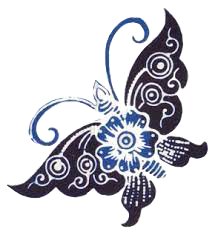East Kalimantan Batik's Development in Contemporary Fashion
Indonesians appreciate batik, an age-old cloth art style, for its elaborate patterns and cultural importance. East Kalimantan batik is distinguished from other regional types by its distinctive motifs that draw inspiration from the area's natural and cultural history. East Kalimantan batik has changed dramatically in recent years as it combines with contemporary fashion styles. This article traces the development of East Kalimantan batik in modern fashion, from traditional workmanship to international design statements.
The province of East Kalimantan on the island of Borneo is known for its natural beauty and diverse range of cultural influences. In this area, batik is a reflection of the indigenous Kayan and Dayak peoples' strong ties to the nature and their customs. East Kalimantan batik, which has designs that symbolize the local flora, wildlife, and cosmology, was traditionally used for ceremonial and traditional reasons.
Wax is applied to fabric and dyed in the traditional batik-making method, which has been handed down through the centuries. Patterns created by this painstaking procedure are not only striking to look at but also have cultural significance. Over time, the introduction of modern materials and techniques began to influence the traditional practices, setting the stage for the evolution of East Kalimantan batik in contemporary fashion.
Modern Fashion's Impact on East Kalimantan Batik
In an effort to introduce the rich legacy of East Kalimantan batik to a wider audience, designers and craftspeople started fusing traditional batik with contemporary fashion. The way batik is viewed and worn has dynamically evolved as a result of this merging of the ancient and the new. This change has been facilitated by a number of important factors:
1. Globalization and Cultural Exchange
The introduction of East Kalimantan batik to foreign markets has been greatly aided by globalization. Fashion designers and fans throughout the world started to take notice of the distinctive batik motifs from East Kalimantan as Indonesian culture acquired international reputation. Collaborations between international fashion brands and local craftspeople have resulted from this exposure, producing creative designs that appeal to contemporary tastes while showcasing the beauty of East Kalimantan batik.
2. Contemporary Design Innovations
By adding modern components to their designs, current designers have reinterpreted traditional East Kalimantan batik themes. Experimenting with novel color schemes, textiles, and clothing designs is part of this innovation. Traditional batik designs, for example, have been transformed into stylish gowns, well-tailored suits, and everyday clothing that can be worn to a variety of events. Additionally, designers have adopted digital printing technology, which makes it possible to replicate historic designs with greater precision and intricacy.
3. Sustainable Fashion Movement
The development of East Kalimantan batik has also been influenced by the worldwide movement towards sustainability. Demand for eco-friendly and ethically made textiles is rising as customers get more aware of the social and environmental effects of the fashion choices they make. The traditional hand-dying methods and natural dyes used in East Kalimantan batik are in line with sustainable fashion ideals. This convergence has resulted in a growing trend of supporting local workmanship and a revitalized respect for the artisanal features of batik.
The Impact of Modern Fashion on East Kalimantan Batik Artisans
The integration of East Kalimantan batik into modern fashion has had a profound impact on local artisans. While this evolution has opened new opportunities for exposure and economic growth, it has also posed challenges.
1. Economic Opportunities
Modern fashion’s embrace of East Kalimantan batik has provided artisans with new avenues for income and recognition. Collaborations with designers and fashion houses have led to increased demand for their craft, allowing artisans to reach a global audience. This economic boost has contributed to the preservation of traditional skills and the growth of local communities.
2. Challenges of Modernization
Despite these opportunities, the modernization of East Kalimantan batik has brought challenges. The influx of contemporary techniques and materials has led to concerns about the preservation of traditional practices. Some artisans worry that the emphasis on mass production and commercial viability may compromise the authenticity of their craft. Balancing the demands of modern fashion with the preservation of cultural heritage remains a key concern.
The Role of East Kalimantan Batik in Global Fashion Trends
East Kalimantan batik’s influence extends beyond Indonesian borders, impacting global fashion trends in several ways.
1. Cultural Appreciation
The growing interest in East Kalimantan batik highlights a broader trend towards cultural appreciation and diversity in fashion. By incorporating traditional motifs into modern designs, fashion designers contribute to a greater understanding and respect for different cultural heritages. This appreciation helps to challenge stereotypes and promotes a more inclusive fashion industry.
2. Innovative Design Concepts
The fusion of traditional batik with contemporary fashion has led to innovative design concepts that push the boundaries of traditional textiles. Designers are experimenting with new ways to incorporate batik into everyday wear, creating garments that are both aesthetically pleasing and culturally significant. This experimentation contributes to a more dynamic and diverse fashion landscape.
Conclusion
The evolution of East Kalimantan batik in modern fashion represents a fascinating intersection of tradition and innovation. As traditional motifs are reimagined in contemporary design, East Kalimantan batik continues to capture the imagination of fashion enthusiasts and designers worldwide. This evolution highlights the enduring relevance of batik as a cultural and artistic expression, while also showcasing its adaptability to modern fashion trends.
By embracing both its rich heritage and its potential for innovation, East Kalimantan batik stands as a testament to the power of tradition in shaping the future of fashion. As the art form continues to evolve, it will undoubtedly inspire new generations of designers and consumers, ensuring that the beauty and significance of East Kalimantan batik remain alive and vibrant in the global fashion landscape.

